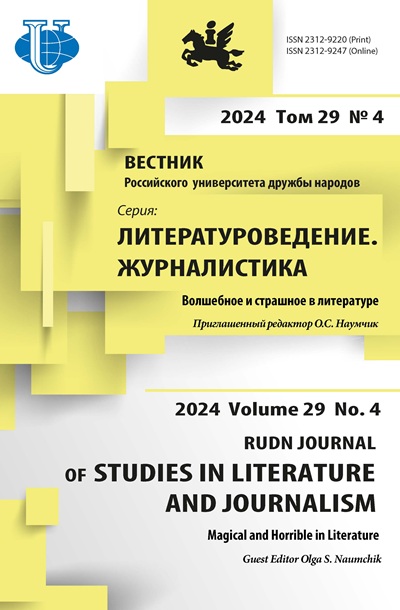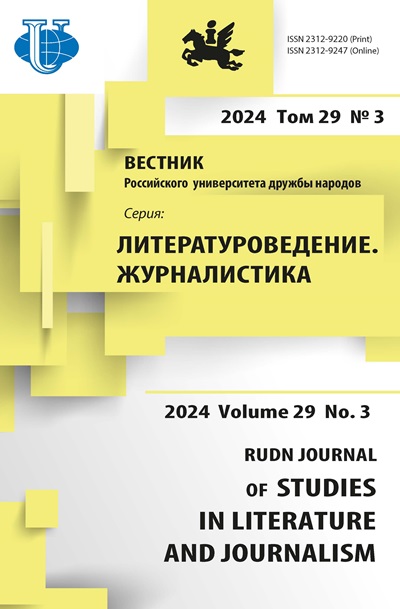“Digital intelligence of a journalist”: To the content of the concept
- Authors: Gavrilov V.V.1, Zorina V.A.2
-
Affiliations:
- Surgut State Pedagogical University
- RUDN University
- Issue: Vol 29, No 3 (2024)
- Pages: 626-641
- Section: JOURNALISM
- URL: https://journals.rudn.ru/literary-criticism/article/view/41921
- DOI: https://doi.org/10.22363/2312-9220-2024-29-3-626-641
- EDN: https://elibrary.ru/GIUQSW
Cite item
Full Text
Abstract
The concept of “Journalist Digital Intelligence” (JDI), its scope and content are the result of the authors’ own reflections based on the works of P. Bourdieu (theory of the individual’s social capital) and P. Yuhyun (norms of the individual’s digital intelligence). The authors of the article study JDI in relation to a journalist’s personality and test it in the context of journalistic activity, while the JDI is updated instrumentally - in relation to media education. In the process of self-identification, a budding journalist is immersed not only in the media space, but also in the digital space. The success of his or her professionalization and social adaptation depends on how well he or she is able to use the advantages of digitalization and how resistant he or she is to its threats. The authors propose to modify the criteria for assessing the quality of university journalism training, adapted to the JDI and taking into account the latest media transformations. The results of a pilot survey of 375 respondents show that it is necessary to add to the existing characteristics of digital intelligence those necessary for a media specialist (in line with the JDI): digital literacy, creative skills, critical thinking, reflection and motivation. Their sum will reflect an individual portrait of a digital personality and will make it possible to assess the level of readiness of a person to enter the media space as a subject of journalistic activity.
About the authors
Viktor V. Gavrilov
Surgut State Pedagogical University
Author for correspondence.
Email: victorg12@mail.ru
ORCID iD: 0000-0002-1279-3066
Candidate of Pedagogy, Associate Professor at the Department of Philological Education and Journalism, Faculty of Philology
10/2 50 let VLKSM St, Surgut, 626417, Russian FederationVioletta A. Zorina
RUDN University
Email: zorina-val@rudn.ru
ORCID iD: 0000-0002-2464-9168
Lecturer, Department of Mass Communications, Faculty of Philology
6 Miklukho-Maklaya St, Moscow, 117198, Russian FederationReferences
- Algavi, L.O., & Al’-Hanaki, D.A. (2014). The term “new media” and its content in modern science. Journalism and Society, 16, 124–133. (In Russ.)
- DeCillia, B., & Clark, B. (2023). Fake news and fact-checking: Combating misinformation and disinformation in Canadian newsrooms and journalism schools. Facts and Frictions: Emerging Debates, Pedagogies and Practices in Contemporary Journalism, 3(1), 86–105. https://doi.org/10.22215/ff/v3.i1.10
- Dinçer, E. (2024). Hard and soft skills revisited: Journalism education at the dawn of artificial intelligence. Adnan Menderes University Journal of Social Sciences Institute, 11(1), 65–78. https://doi.org/10.30803/adusobed.1462061
- Ershov, Yu.M. (2016). Models of journalism education in the digital era. Journalist Yearbook, 5, 13–16. (In Russ.)
- Evdokimov, V.A. (2018). Information space and media space: correlation of concepts. Russian Journal of Social Sciences and Humanities, 4(34), 47–52. (In Russ.) http://doi.org/10.17238/issn1998-5320.2018.34.47
- Gardner, H. (2006). Multiple intelligences: New horizons in theory and practice. New York: Basic Books.
- Gradyushko, A.A. (2020). Digital technologies in the work of regional media: the results of a survey of chief editors. Journal of the Belarusian State University. Journalism, 1, 28–33. (In Russ.)
- Gutiérrez-Caneda, B., Vázquez-Herrero, J., & López-García, X. (2023). AI application in journalism: ChatGPT and the uses and risks of an emergent technology. Profesional De La información, 32(5). https://doi.org/10.3145/epi.2023.sep.14
- Ilyakhina, A.A., & Deeva, I.V. (2024). Prospects for the application of artificial intelligence technologies in journalism. Science Bulletin, 3(1), 580–588. (In Russ.)
- Ivanov, A.D. (2015). The robotic journalism and the first algorithms on service of editions of the international mass media. Sign: problematic field of media education, 16(2), 32–40. (In Russ.)
- Ivanov, A.D. (2017). Transparency of roboted journalism: how the new technologies threaten the principles of the profession. Bulletin of Chelyabinsk State University (Philology Sciences), 107(8), 28–33. (In Russ.)
- Katamba, M., & Kayıhan, B. (2024). A descriptive analysis for the future of journalism studies in emerging artificial intelligence (AI) and the case of NewsGPT platform. Yeni Medya, 16, 1–18. https://doi.org/10.55609/yenimedya.1427421
- Kilpelyainen, E.S. (2019). Transformation of professional competencies of a journalist in the period of digitalization of the media space. (Ph.D. Dissertation abstract). Moscow. (In Russ.)
- Kumar, S., Samadhiya, S., Singhal, S., Agrawal, S., Santhosh, S., & Arora, S. (2022). Future of media and journalism – Through the hands of man to AI. Researchgate.net. December. https://doi.org/10.13140/RG.2.2.14147.89129
- Oleshko, V.F., & Gavrilov, V.V. (2022). Formation of an integral media personality of a future journalist in a regional university in the context of digitalization of the media. Sign: problematic field of media education, 4, 6–12. (In Russ.)
- Rubtsova, N.V. (2024). Neural networks in media: opportunities, problems, prospects for future media specialists. Theoretical and Practical Issues of Journalism, 13(1), 156–171. (In Russ.) https://doi.org/10.17150/2308-6203.2024.13(1).156-171
- Shesterkina, L.P. (2013). Journalistic education and universalization of the profession: experimental experience: monograph. Chelyabinsk: REKPOL Publ. (In Russ.)
- Shmatko, N.A. (2005). “Social space” of Pierre Bourdieu. In: Bourdieu P. Social space: fields and practices. St. Petersburg: Institute of Experimental Sociology; Aletheia. P. 554–574. (In Russ.)
- Urazova, S.L. (2013). Digital media space in the paradigm of institutional and social. Vestnik of Novosibirsk State University (“History and Philology” Series), 12(10), 39–44. (In Russ.)
- Vartanova, E.L., Gladkova, A.A., & Dunas, D.V. (2022). Digital capital as hybrid non-material capital: theoretical approaches and practical solutions in the Russian context. Theoretical and Practical Issues of Journalism, 11(1), 6–26. (In Russ.) https://doi.org/ 10.17150/2308-6203.2022.11(1).6-26
- Volkova, I.I., & Lazutova, N.M. (2017). Screen media and human ecology: from charming to joining. Vestnik of Orenburg State University, 12(212), 106–111. (In Russ.) https://doi.org/10.25198/1814-6457-212-106
- Volkova, I.I., Urazova, S.L., & Pisareva, M.N. (2020). Criteria for forming a communicative space in the student environment: immersion in creativity. Scholarly Notes of Transbaikal State University, 15(1), 75–81. (In Russ.)
- Zagidullina, M.V. (2012). Information society in the context of net-thinking. Bulletin of Chelyabinsk State University, 5, 48–51. (In Russ.)
- Zorina, V.A., & Osipovskaya, E.A. (2021). Literature review on artificial intelligence in journalism: a bibliometric analysis of publications indexed in the Web of Science and Scopus. Theoretical and Practical Issues of Journalism, 10(4), 734–744. https://doi.org/10.17150/2308-6203.2021.10(4).734-744
Supplementary files




















